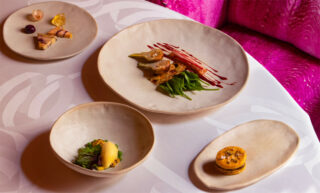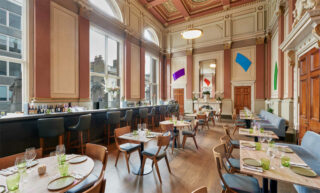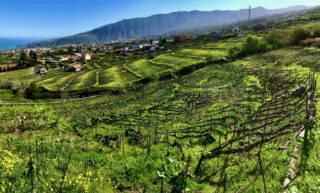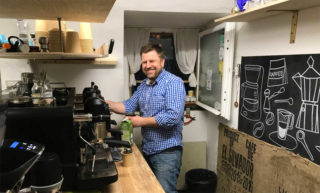Star chef stages new act
“I am not ambitious”, star chef Quique Dacosta said during our recent conversation. Since we first spoke to him in 2005, his eponymous restaurant rose to the highest echelons of fine dining. It has three coveted Michelin stars and it is a fixture on the list of the world’s best restaurants.
A striking change is his shift from quality of produce to origin of the dish. Moreover, his brand has expanded with four new restaurants in Valencia and his first international endeavor is in the making. A chef without ambition? Time for a reacquaintance with one the world’s leading chefs.
Quique Dacosta’s story reads like an American dream. Arriving from the deprived province of Extremadura in Spain on the border with Portugal, he started scrubbing pots in a local trattoria in Dénia. Teaching himself with cookbooks from his culinary heroes, he eventually reached superstar status.
In 2005, Dacosta strongly stressed the fact that the quality of produce was the key to his success. Nowadays, his focus is more on the origin of the dish. The title of the current seasonal menu “Evolucion y el Origen” (Evolution and Origin) seems to prove the point. “Unlike Barcelona and the Basque Country, Valencia has never been on the Spanish gastronomic map”, Dacosta says. “I didn’t agree, as this part of Spain has many things to offer. It became our goal to tell the world what we have here. Quality remains however one of the cornerstones of what we do. You may be able to make a ground-breaking sculpture from recycled plastic, in a world-class restaurant the ingredients have to be perfect and one hundred percent fresh.”
The Basque Country, given its distinct climate and landscape and its different language, is a world in itself indeed. But is Barcelona really that different from Valencia? “At first sight, you may think that the differences between Barcelona and Valencia are small”, Dacosta explains. “But in Spain, the cultural differences can be notable, even over short distances. You only need to go to Tarragona, just half way between Valencia and Barcelona, to experience this. Calçots (leeks) are very typical for this area, but you won’t see them so often in Barcelona or Valencia. Moreover, the people in the area around Valencia and Dénia are open to innovation, something for which they do not always get the acknowledgement their peers in Barcelona or Madrid get.”
Salt Tunnel
As the conversation continues, innovation and avant-garde are returning themes. “Any business needs innovation to survive in the long run,” Dacosta elaborates. “Just the thought of doing something new stimulates me. Each season we design a new menu. Innovations also trigger innovations. Within my team some people have time to dedicate themselves to trying out things. Since this year, for instance, we have a dish from our new “salt tunnel” on the menu.”
We know salt as a tastemaker and a preservation agent. But Dacosta doesn’t want to say much about the salt tunnel yet. “We will tell you at the table, but keep in mind: it is about cooking with salt.”
An hour later, at our table, more aptly stage (read on), his salient suggestion became crystal clear. Our menu consisted of six so-called “acts”, groupings of one or more dishes. Act two, called “Cooking with salt, air, humidity and time”, showcased new dishes from 2018. The piece the resistance was a display of eight roes and pieces of fish and seafood with which Quique Dacosta really pushed our sensory boundaries.
Our first bite was a slice of ventresca del atún or tuna belly, the most desirable part of the fish, which had been cured for five to six months (!) in the salt tunnel, an innovative, manicured environment (the size of large refrigerator) where the tuna rests in a saline ambient, without ever actually touching the salt. At low temperature and high humidity and under constant air circulation the salt ions “cook” the tuna belly, hence, “cooking with salt”, although in a completely unconventional way. As there is no physical contact between the fish and the salt, the fish doesn’t dry out. This novel technique strikes the fine balance between preservation and cooking without dessication. The result was pleasantly moist and tender.
Besides a slice of the traditionally dried and charred octopus, dramatically served on its dark and stormy tentacles at the center of the table, there was a trolley with six other preparations – placed on whitewashed blocks of weathered wood – of which you can choose two. Aperitif was treated to all six of them: a bottarga of mullet (salt-touched and sun-dried), another piece of tuna (smoked and with several days of tunnel-preparation, enhanced with a dollop of smoked aubergine), a slice of cuttlefish (it looked like lardo, but, although very tender, it had a different texture and a mildly marine flavor), cod roe (seasoned and presented as a sobrasada (footnote 1) and cured in the tunnel for three to four weeks), a teaspoon of ling fish roe (a typical Spanish delicacy, cured in salt and presented as if it were an Extremaduran torta del casar, a soft cheese that you scoop out) and finally a piece of tuna from the spine (treated with rock salt to press out the water).
Most of the fishy bites hit the taste buds as new, exciting sensations that do not always instantaneously please: briny and fatty, obviously, but also with notes of cod liver oil. Treatment in the salt tunnel kept the looks of the tuna as if it were fresh, but added a taste of being cured or fermented. It reminded vaguely of my first acquaintance with bacalhau (dried and salted cod), an acquired taste.
The palette cleansers were proof that “no part is too small” in a well-cast production. Ruby red chards of pomegranate vinegar soaked onion, and vibrant, plump stalks of raïm de pastor, a type of sedum we saw growing along the coast just that same day.”
Cream of sea urchin and fermented tomatoes
Callas
Our suggestion that Dacosta is now the king of new Valencian cuisine is greeted with restraint. “Perhaps. I see it as my duty to preserve and revive the old dishes and preparation techniques of this area.”
And sure enough, some dishes were ostentatious reinterpretations of local classics or old techniques. The typical Denia prawn, for instance, served alongside a double-layered soup of (orange) prawn heads and (green) Swiss chard tea; or the duck from the Albufera lagoon south of Valencia; or the exquisite cauliflower rice dish with sweetbreads of the Guirra sheep (footnote 2). Some others, like the raw shrimps with almonds covered with thin sheets of crispy almond milk paper, seem to have looser ties with the region. The most striking example however, was the revival of garum, a Mediterranean sauce of fermented fish from ancient Greek and Roman times, at Dacosta’s made of the head and the liver, brightened with Persian black lime.
At several occasions Dacosta has pointed out he draws inspiration from the arts. How does that show? “Many chefs are inspired by the arts. For me it doesn’t translate into an artistic presentation. It is rather a sensation. A dish has to be good by itself.” Somewhat cryptically, and implicitly putting himself in the same realms as the greatest voice of all times he added: “Callas too needed a good opera to excel.” This triggered us to ask about the “acts” Dacosta uses to group his dishes together within the tasting menu. Are the diners the audience of an opera or play his team is staging?
“I wasn’t particularly inspired by opera or theatre. We normally like to serve our aperitif and appetizers on the terrace and our desserts in the sitting room. “Stages” or “podiums” may have been better words. We do consider dinner at Quique Dacosta a bit as a play, but one in which staff and diners are both the actors.”
Quique Dacosta is easy to speak with. Although we needed his headwaiter Giovanni Mastromarino as an interpreter, the conversation was smooth. Short and slender, dressed in darkgrey skinny pants and a white monogrammed slim-fit shirt, Dacosta sat down with a cup of coffee at the armrest of a sofa as if he could jump up anytime to go back into the restaurant. But nothing was less true. He took more time for the conversation than the agreed twenty minutes. It almost made us think he is a spontaneous person. But room for spontaneity only exists for the people developing new dishes. Otherwise things are strictly choreographed at Quique Dacosta Restaurante. “Spontaneity is creativity, but I am a perfectionist out of respect for my customers. I can’t serve anything experimental. Research and investigation is one of our standards. When we start serving a new dish to our customers, we need to know exactly how to reproduce it every night in exactly the same way.”
Dacosta’s investigative nature also shines through when we talk about his new venture in London. Under the working title InPaella, he will open a restaurant focusing on rice-based dishes cooked on an open fire. Think Paella, the iconic Valencian dish, but more diverse. For this, he worked with a wood expert from the UK, who taught him everything about cutting and drying different types of wood and how much heat each one of them produces. Wood is, however, not just a source of heat, it also releases different aromas. As if on cue he demonstrated his love for research: “This is creativity.”
Asked for some examples, he continues: “As the best pigs for our famous Iberian pork feed on the acorns of the encina tree (footnote 3), our rice-and-pork dish will be cooked on this type of oak. Because of its aromas our dish of rabbit and snails is better off on vine wood.”
With his ventures in Dénia, Valencia and soon in London, Dacosta seems to be a workaholic of sorts. Given the smoothness of the conversation, we dare to ask if his enormous drive could be related to the loss of his brother in a terrible accident? “As a matter of fact, the loss of my father and my grandfather within a time frame of just three months when I was still young left a bigger mark. Back then, as a teenager, I found comfort between the walls of the kitchen. It may as well have planted the seed for my future career, although I wasn’t aware of it at the time.”
Slice of dry tomato sprinkled with rice vinegar
Dacosta’s growing culinary brand seems proof of great ambitions, although this is resolutely denied. “I am not ambitious. When the financial crisis started to hit in, the number of clients at my Dénia restaurant started to dwindle. It was pure necessity when I opened my first restaurant in Valencia.”
So, there are no further plans, we wonder? “I could roll out one of my Valencia restaurants in other cities, but I don’t like to copy. I want every restaurant to be unique. Right now I see myself mostly as a creator of restaurant concepts. Décor, music, cooking, every aspect needs to be right and has my interest and attention”, effectively leaving it unclear what the future holds in store. However, Dacosta’s energy doesn’t seem to have depleted. “I don’t do anything in particular to relax. I just love to work. But if I am not with my two children, the place where I prefer to be is my restaurant in Dénia. I would love to have a Harley Davidson, but I just bought a twenty thousand euro oven for my new restaurant Llisa Negra in Valencia.”
Just as the lingering cherry notes of the elusive Simeta red wine by local vintner Javi Revert, accompanying our fifth act, the dinner at and the conversation with Quique Dacosta remained with us until weeks later. Ambitious or not – judge for yourself – the restaurant bug has Dacosta firmly in its grip. So, don’t be surprised if, after the opening of InPaella and Llisa Negra, other restaurants will be staged under the Quique Dacosta brand.
Dessert: Strange flowers
1. – A sobrasada is a raw, cured sausage seasoned with pimiento or paprika that comes originally from the Balearic islands. The distance between this group of Mediterranean islands and the Spanish mainland is shortest at Denia.
2. – The Guirra sheep is a rare Spanish breed that you find mostly in the area of Valencia / Alicante
3. – The encina (or evergreen oak) with sweet acorns grows in large parts of southwestern Spain in semi-open man-made landscapes known as the dehesa. If you drive up from the sea into the hills surrounding the horseshoe-shaped valley surrounding Denia, orange and mandarine trees give way to almond and cherry trees and finally the encina. The best pigs for Iberian pork are fed on the encina’s slightly elongated acorns.
Restaurante Quique Dacosta
C/ Rascassa, 1 – Urb. El Poblet, Denia
T: +34 96 578 4179
quiquedacosta@quiquedacosta.es
Michelin: ***
The World’s 50 Best 2018: #68
Restaurante El Poblet
C/ Correos, 8 – 1st floor – Valencia
T: +34 96 111 1106
elpoblet@elpobletrestaurante.com
Michelin: *
Vuelve Carolina
C/ Correos, 8 – Valencia
T: +34 96 321 8686
E: vuelvecarolina@vuelvecarolina.com
MercatBar
Calle Joaquín Costa, 27 – Valencia
T: +34 96 3748558
mercatbar@mercatbar.es
Llisa Negra
C/ Pascal y Genís, 10 – Valencia
T: +34 699 183 770
llisanegra@llisanegra.com
A Norwegian adaptation of this article was published in the March 2019 issue (print) of Apéritif magazine.








Comments